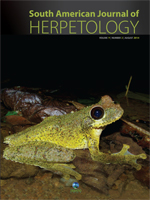Vitreorana uranoscopa inhabits small or medium-sized streams with rocky bottoms of the Interior Atlantic Forest of eastern Brazil, northeastern Argentina, and likely southeastern Paraguay. Most of the available information originates from Brazilian populations. Only a few populations from Argentina have been reported and information about their natural history is almost unknown. This work re-describes the advertisement call of V. uranoscopa from a new population discovered in the province of Misiones, Argentina, and includes further data about its reproduction, population density and habitat conservation status. On the basis of 11 recorded males, two call types were recorded. Results showed that the typical advertisement call is formed by pulsed notes released singly, in groups, or in combinations of both at an average rate of 13.86 notes/min. Notes lasted 0.013–0.085 s and had 1–5 well-defined pulses lasting 0.003–0.015 s; the pulse repetition rate was 90.9–166.66 pulses/s. The peak of dominant frequency was 4,312.5–4,875.0 Hz with a slight, ascending frequency modulation. These data agree with those reported in previous studies, although some differences in the note duration, intercall interval, number of pulses and harmonics were identified. These differences might be due to either the technological limitations at the time of those studies or interpopulation variation. The second call type (reported for the first time in V. uranoscopa) is formed by 1–2 additional pulses at the beginning of some notes and has lower amplitude than typical calls, but the social context of its emission is still unknown. The calling males perched on the leaves of the marginal vegetation, either alone or occasionally in groups of 2–3 individuals, with a average of 5.5 individuals per 100 m transect. Clutches containing up to 36 eggs or embryos were found on the upper surface of fern fronds. In Argentina, V. uranoscopa occurs only in Araucaria forests of the Interior Atlantic Forest. Thus, the protection of streams with abundant marginal vegetation seems to be essential for the conservation of this species.
How to translate text using browser tools
1 August 2014
Re-Description of the Advertisement Call of Vitreorana uranoscopa (Müller, 1924) (Anura, Centrolenidae) from the Argentinean Atlantic Forest, with Notes on Natural History
Víctor Hugo Zaracho
ACCESS THE FULL ARTICLE





